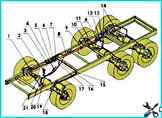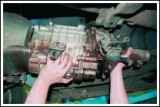Features of the oil system of KAMAZ 740.11-240, 740.13-260, 740.14-300 engines
Combined lubrication system with a “wet” sump
The system includes an oil pump, an oil purification filter, a water-oil heat exchanger, an oil sump, an oil filler neck, an indicator tube and an oil level indicator.
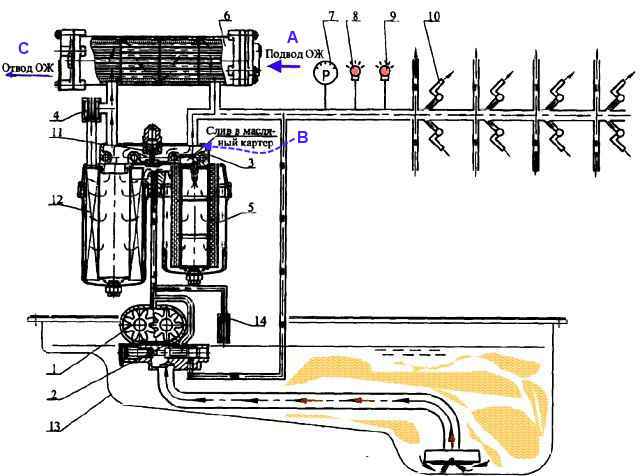
The lubrication system diagram is shown in Fig. 1
From the crankcase 13, the oil pump 1 supplies oil to the oil purification filter 3 and through the water-oil heat exchanger 6 to the main line, then to consumers.
The lubrication system also includes system 2 valve, which provides a pressure in the main oil line of 400-550 kPa (4.0-5.5 kgf/cm 2) at the rated engine speed, safety valve 14, adjusted to a pressure of 931-1127 kPa (9.5-11.5 kgf/cm 2), bypass valve 4, adjusted to operate when the pressure drop across the filter is 150-220 kPa (1.5 -2.2 kgf/cm 2) and thermal valve 11 for turning on the water-oil heat exchanger.
When the oil temperature is below 95 °C, the valve is open and the main flow of oil enters the engine bypassing the heat exchanger.
When the oil temperature is more than 110° C, the thermal valve is closed and the entire oil flow passes through the heat exchanger, where it is cooled with water.
This ensures quick warm-up of the engine after starting and maintenance of optimal temperature conditions during operation.
Structurally, the thermal valve is located in the oil filter housing.
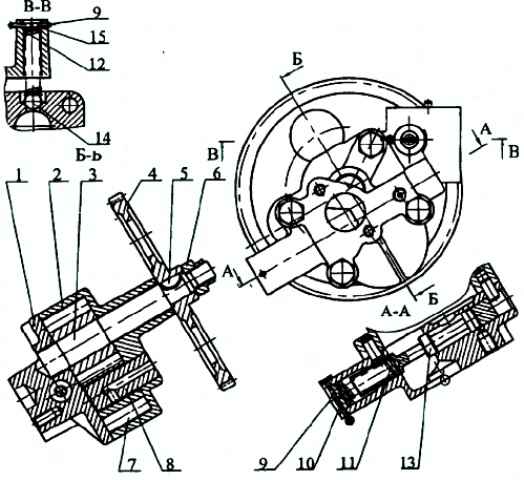
The oil pump (see figure) is mounted on the bottom plane of the cylinder block.
The drive gear is pressed onto the front end of the crankshaft and has 64 teeth, the driven gear 52, that is, a gear ratio of 0.8125.
The clearance in the engagement of the drive gears is regulated by spacers installed between the mating planes of the pump and the block, which should be 0.15-0.35 mm, the tightening torque of the bolts securing the oil pump to the block should be 49-68.6 N.m (5 -7 kgf.m).
Gear oil pump, single-section. Contains body 2, cover 1 and gears.
The cover contains a lubrication system valve 13, with a spring 11.
A safety valve is installed in the discharge channel, consisting of a ball, spring and adjusting washers.
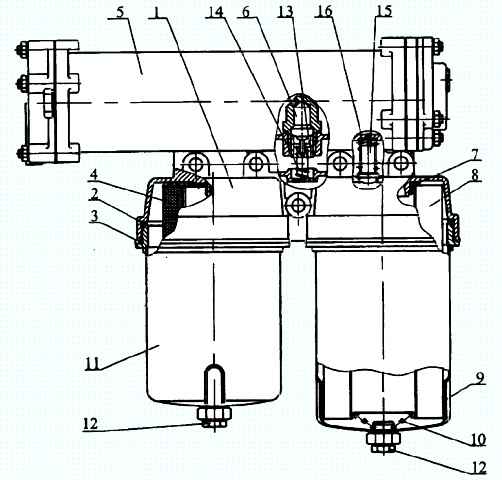
The oil filter (see figure) is mounted on the right side of the cylinder block and consists of a housing 1, two caps 9 and 11, in which full-flow 8 and partial-flow 4 filter elements are installed.
Threaded caps are screwed into the body. The sealing of the caps in the body is carried out by rings 2 and 3.
The filter housing also contains a bypass valve 15 and a thermal valve for turning on the water-oil heat exchanger.
Combined oil cleaning in the filter.
The main oil flow passes through the full-flow filter element 8 before reaching consumers; the fineness of oil purification from impurities is 40 microns.
Through the partially in-line filter element 4, 3-5 l/min passes. where impurities larger than 5 microns are removed.
Oil is drained from the partial molasses element into the crankcase. With this scheme, a high degree of oil purification from impurities is achieved.
The oil sump is stamped and attached to the cylinder block through a rubber-cork gasket. The tightening torque of the crankcase mounting bolts is 8 - 17.8 Nm (0.8 - 1.8 kgf.m).
The thermal valve for turning on the water-oil heat exchanger consists of a spring-loaded piston 13 with a thermal power sensor 6.
At temperatures below 93 °C, piston 13 is in the upper position and the main part of the oil flow, bypassing the heat exchanger, enters the engine.
When the oil temperature reaches (95+2) °C washing the thermal power sensor 6, the active mass located in the cylinder begins to melt and, increasing in volume, moves the sensor rod and piston 13.
At an oil temperature of (110+2) °C, piston 13 separates the cavities in the filter before and after the heat exchanger and the entire oil flow goes through the heat exchanger.
When the oil temperature exceeds 115 °C, the temperature sensor is triggered and the warning light on the instrument panel lights up.
The water-oil heat exchanger (Fig. Oil filter with heat exchanger) is installed on the oil filter, shell-and-tube type, prefabricated.
Coolant from the engine cooling system passes inside the tubes, oil passes outside.
On the oil side, the tubes are finned in the form of cooling plates.
The oil flow in the heat exchanger crosses the water tubes four times, thereby achieving high oil cooling efficiency.
On engines 740.11-240, 740.13-260 and 740.14-300 two types of heat exchangers are installed:
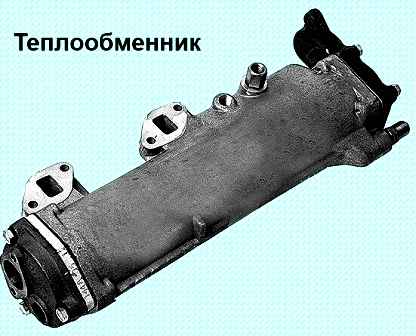
- - 740.11-1013200 for engine 740.11-240,
- - 740.20-1013200 for engines 740.13-260 and 740.14-300, which differ in length.
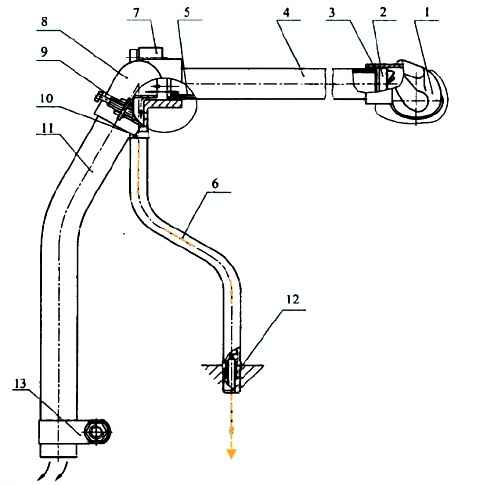
Crankcase ventilation system (see figure) is open, cyclone type. Crankcase gases are removed from the rod cavity of the second cylinder, through angle 1, in which swirler 2 is installed.
When the engine is running, crankcase gases, passing through swirler 2, receive a screw motion.
Due to the action of centrifugal forces, oil droplets contained in the gases are thrown towards the wall of pipe 4 and through pipe 6 are drained back into the crankcase.
Cleaned crankcase gases are removed to the atmosphere.
Possible malfunctions of the diesel lubrication system and solutions
Fault
- Cause of malfunction
Remedy
Increased oil consumption
- Long-term engine operation at idle speed.
Do not operate at engine idle speed unless necessary.
- Oil leakage through connections in the turbocharger lubrication system.
Tighten connections, replace gaskets and rubber sleeves if necessary.
- Wear of the valve-bushing interface in the cylinder head, aging of the rubber valve seal.
Check and replace worn parts.
- Clogged air cleaner or air intake hood.
Service the air cleaner and clean the hood mesh.
Reducing oil pressure in the lubrication system
- Low oil level in the oil sump.
Check and, if necessary, add oil to mark “B”
- Malfunction of pressure control devices
Make sure the devices are working properly
- Use of oil of inappropriate viscosity
Replace the oil with one that corresponds to the chemical chart.
- Contamination of oil filter filter elements
Replace filter elements.
- Misadjustment or jamming of the safety valve or lubrication system valve
Check the valves and eliminate jamming, adjust or replace faulty parts if necessary.
- Clogged oil pump intake
Rinse the intake
- Coolant getting into the oil
Check the tightness of the water cavity, the seal of the cylinder liners, the tightness of the water-oil heat exchanger, replace faulty parts.
- Oil leaks at joints and oil lines of the lubrication system
Check the condition of process plugs, plugs, tightness of fasteners at joints, condition of O-rings and gaskets
- Oil pump malfunction
Remove the pump and check its functionality on a special stand.
- Unacceptable increase in clearance in crankshaft and camshaft bearings
Repair the engine.
Signal lights up emergency oil temperature analyzer
- Malfunction of emergency oil temperature sensor
Make sure the sensor is working properly and replace it if necessary.
- Thermal valve for turning on the heat exchanger is stuck, the thermal power sensor is faulty
Check the operation of the thermal valve for turning on the heat exchanger, if necessary, eliminate jams or replace the sensor.
- Clogged tubes or dirty cooling plates
Check the water-oil heat exchanger for clogged tubes and contamination of the cooling plates, rinse or replace the heat exchanger if necessary.
Increasing oil pressure in the lubrication system
- High oil viscosity
Replace the oil with one that corresponds to the chemical chart
- Loss of tightness of the control signal line connecting the main oil line to the pump or its clogging
Check the oil supply pipe to the pump, the tightness of the mounting bolts, and the presence of a hole in the cover
- Sticking or maladjustment of the lubrication system valve.
Check the valve and eliminate jamming, if necessary, replace faulty parts.
Repair of oil system elements
To disassemble, assemble and check the oil pump:
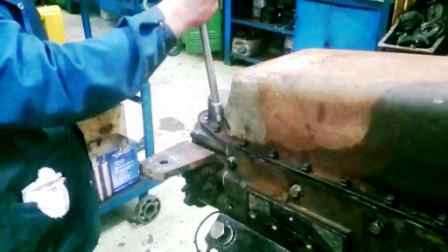
— drain the oil from the crankcase, unscrew the mounting bolts and remove the crankcase;
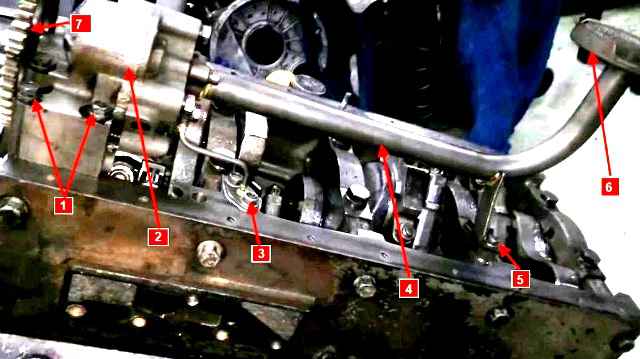
- - remove the suction tube 4 (Fig.) with the flange, bracket and cup assembly and the supply pipe to the lubrication system valve;
- - unscrew the oil pump 1 mounting bolts, remove the pump;
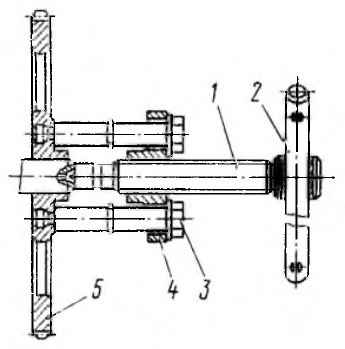
- - remove the oil pump gear using a puller I80 1.02.000 (Fig.), to do this, screw bolts 3 into gear 5 until they stop, press screw 1 against the end of the shaft.
Rotate the handle and screw the screw into the yoke until the gear is completely removed;
- - unscrew the bolts securing the pressure and radiator sections of the oil pump and disassemble it;
- - measure the radial and end clearances of the discharge and radiator sections, the gaps in the meshing of gear teeth in the radiator and discharge sections, between the drive shaft and the hole in the housing, between the axle and the gear. If necessary, replace worn parts;
- - when assembling the pump, do not reuse the bend washers.
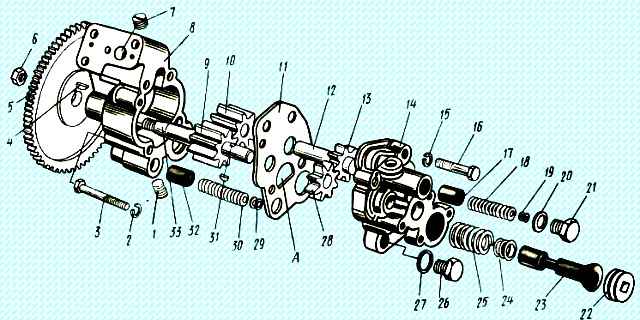
After assembling the pump, the roller should rotate smoothly by hand, without jamming;
- test the pump on a stand using M10G2K or M10DM oil.
At a roller rotation speed of 2800 - 60 min -1 and a suction vacuum of 12-15 kPa, the pump flow should be at least 130 l/min with an outlet pressure of 0.35 - 0.40 MPa ;
- adjust the response pressure of the lubrication system valve, which should be 0.40 - 0.45 MPa.
For adjustment, it is allowed to use no more than 3 washers installed under the spring.
If the pressure does not match when the valve starts to open, replace the spring. Reuse of the plug cotter pin is not permitted.
Tightening torques of threaded connections, Nm (kgcm)
- Oil pump mounting bolts 49.0 - 68.6 (5 - 7)
- Cover mounting bolts 39.2 - 54.9 (4 - 5.6)
- Bolts securing the tube to the pump 19.6-24.5 (2-2.5)
- Oil filter caps 49.0 - 58.8 (5 - 6)
- Filter thermal valve plug 47.0 - 58.8 (4.8 - 6)
- Drain plugs for caps 24.5-39.2 (2.5-4.0)
- Oil filter mounting bolts 88.2-112.6 (9.0-12.5)
- Nut securing the driven gear of the oil pump drive 98.1-117.6 (10-12)
Dimensions of parts and permissible wear, mm
- Gear diameter 55.44 - 55.47
- Permissible gear diameter 55.4
- Radial clearance between gear teeth and housing wall 0.130-0.206
- Permissible radial clearance 0.25
- Gear height 34.913 -34.975
- Allowable gear height 34,900
- Well depth 35,050-35,089
- End clearance 0.075-0.176
- Permissible end gap 0.2
- Diameter of roller necks 19.920 - 19.899
- Acceptable neck diameter 19.85
- The diameter of the bushings in the housing for the roller necks is 19.98-19.959
- Permissible diameter of bushings 20.10
- Axle diameter 19.987 - 20.000
- Allowable axle diameter 19.85
- Diameter of driven gear bushings 20.040-20.073
- Allowable bushing diameter 20.080
- Valve plunger diameter 15.968-15.941
- Allowable plunger diameter 15.92
- The diameter of the hole in the cover for the valve is 16,000-16,027
- Valve spring force compressed to size 44 mm, N 60-74
To disassemble, assemble and check the oil filter:
- - drain the coolant from the engine cooling system;
- - unscrew the drain plugs from the caps and drain the oil from the filter;
- - disconnect the coolant inlet and outlet pipes to the heat exchanger;
- - unscrew the five mounting bolts and remove the filter with the heat exchanger;
- - unscrew the nuts and disconnect the heat exchanger from the filter;
- - unscrew the caps from the body, wash the internal cavity with diesel fuel, check the integrity of the sealing rings and thrust springs, replace if damaged;
- - check the assembled filter for leaks with compressed air 490 kPa in water;
- - check the pressure at which the bypass valve begins to open, which should be 0.147-0.216 MPa;
- - check the functionality of the thermal valve for turning on the heat exchanger.
At oil temperature (50-70) °C, the flow rate through the valve must be at least 70 l/min at a pressure of 0.147 kPa and no more than 5 l/min at a temperature of 100-110 °C.
If necessary, replace the thermal power sensor TC 103-1306090-30.
To disassemble, assemble and check the operation of the water-oil heat exchanger:
- install plugs on the oil supply flanges and pressurize the oil cavity with a pressure of 0.79-0.83 MPa in water; if a leak is detected, remove the inlet and outlet manifolds of the heat exchanger and remove the core from the housing, replace the O-rings or, if the tubes are damaged, the core .
